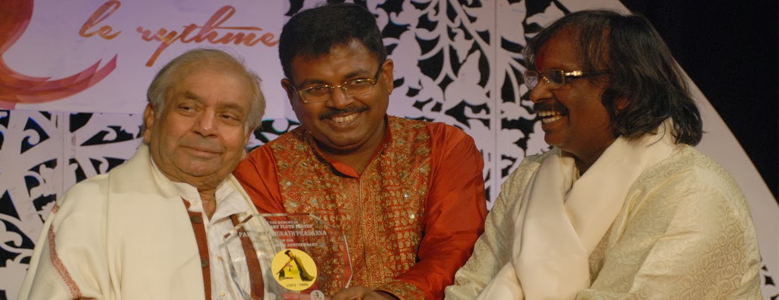GHARANA

GHARANA
Benaras, the holy city of India, has been the cultural centre of music and art for thousands of years. The city is well- drenched and completely soaked in the great tradition of the Indian classical music both in vocal and instrumental.
Artist from every genre have interacted with this great city and found spiritual solace that amply reflected in their artistic pursuits.
The city also boasts of giving rise to numerous great maestros of music, including Pandit Raghunath Prasanna, the doyen of wind instruments both shehnai and flute. However, Pandit Raghunath’s contribution in the realm of wind instruments has been unique. The title ‘Prasanna’ have been entitled to Pandit Raghunath by the king of Kuch Bihar. The king honored him as Pandit Raghu Nath Prasanna made audience happy, from then he has been named as “Prasanna” . That’s why he is responsible to firmly establish what has now come to be known as “Prasanna Gharana” of flute playing.
Pandit Raghunath Prasanna was not only a refined artiste who could play both shehnai and flute with equal ease; he was a great teacher and innovator. He got his musical training from his father Pandit Guari Shanker, a shehnai player of repute, and gayaki ang from Pandit Dauji Mishra of Varanasi. He was the first person in the family to introduce the art of flute playing in Banaras Gharana of India which known for its shehnai playing for more than two and half centuries. The shehnai in this family was earlier strengthen for many generations by Pandit Raghunath’s father Pandit Gauri Shanker, Pandit Tehal Prasad (Grand- father), Pandit Garib Das (Great Grand- Father).
Pandit Raghunath Prasanna was not only a flautist of great merit; he developed various techniques in the realm of flute playing so as to faithfully reproduce the subtleties and nuances of the Indian classical music. In fact, he was responsible to provide a strong base to his Gharana by training his own family members including his son Pandit Rajendra Prasanna globally known for his melodious music.
Pandit Raghunath Prasanna was not only a legend flute and shehnai player. He initiated into the art of flute playing from the instrument named Tripura bansuri and took this Tripura bansuri to Indian classical music and then he started Krishna Bansuri. Pandit Raghu nath Prasanna also played sarod. He was an excellent instrument- maker, Ustad Bismillah khan used to call him “Vishkarma”- an Indian God, when saw his quality as an instruments maker.
Pandit Raghunath Prasanna is the first in Prasanna family to introduce flute, and after him his style has spread all over India. It should be noteworthy that the tools and techniques developed by Pandit Raghunath Prasanna have been widely adopted by many of the Indian flautists including his younger brother and disciple Pandit Bholanath Prasanna and his disciple Pandit Hari Prasad Chaurasiya, Pandit Rajendra Prasanna, Pandit Ronu Mujamdar and many others flautists.
Pandit Raghunath Prasanna was the recipient of various awards and honors including Sangeet Natak Academy Award (1996) for his contribution to the cause of Indian Classical Music.
The Legacy Continues The musical journey started by Pandit Raghunath Prasanna is being fast – forwarded by his able son Pandit Rajendra Prasanna who is well- known in the global musical circuit both in the sphere of the shehnai and flute playing. He imbibes the best elements of the Benaras tradition in playing the Raga music as also the folk melodies of India.
The art of flute playing is being further nurtured by Pandit Rajendra Prasanna’s talented sons- Rajesh Prasanna, Rishab Prasanna, Ritesh Prasanna; who have taken to the art of flute playing very seriously and are making waves in the musical circuits both within and outside the country.
Prasanna Brothers The Prasanna family gets further boost with the Prasanna brothers – Rajesh Prasanna & Rishab Prasanna, taking the central stage and making their mark both as soloist as also duet players of flute in the country. Their meritorious rise as the country’s ace flautists is evident from a plethora of media reviews that have appeared in a number of newspaper and magazines.